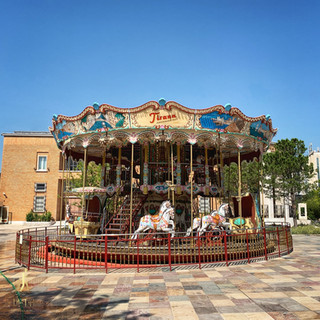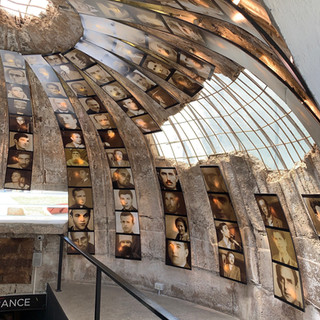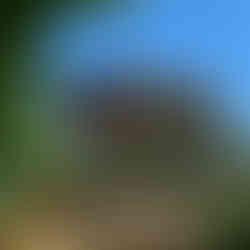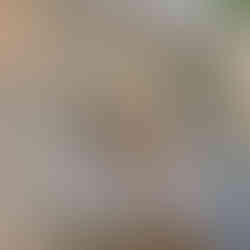Shqipërisë, I am sure you are wondering what this means. Nope it's not a made-up word, it's boldly written on the bank building at Skanderbeg square. So what does it mean?
Albania in ancient times was known as Illyria and in the Middle Ages they called their country "Arb'r" or "Arb'n".
Since the 16th century, however, Albanians themselves have called their language Shqipe, their country Shqiperia and themselves Shqiptare. Albanian scholars believe that these names are derived from the word shqiptoj, meaning to speak intelligibly. Some texts say Albanians call their country Shqipëri, which means "land of eagles."

Surrounded by mountains, I mean this literally, and in the center of Albania lies its capital city Tirana.
The Lanë or Lana river is the main stream that crosses through the Albanian capital.

Tirana is easily one of the most colorful cities in the Balkans. Painted facades, street art and graffitis, murals can be seen on the streets.
Skanderbeg square is the main tourist attraction in the center of Tirana. It commemorates Gjergj Kastrioti Skënderbeu or Skanderbeg (1405–1468), the national hero in Albania who resisted the Ottomans.
Around the square you'll find the Opera, Et'hem Bej mosque, government buildings, the National historic Museum, the clock tower and other tourist attractions.
Did you know that Tirana has pyramids? Yep they do. They structure was once a museum in 1988, and after the collapse of communism in 1991, it became a conference center. During the Kosovo was 1999, it was also used as a NATO base. Currently it is closed and I am not sure what it will be transformed into in the future.


Having gone through Ottoman, Fascist and Soviet eras, Albania is also known for its many bunkers, built under the dictatorial regime of dictator Enver Hoxha. It is said to have more than 173,000 bunkers of various sizes have been built throughout, and you can find them on the coast, in cities and in the hills.
BUNK'ART 1 is a Cold War bunker and BUNK'ART 2 is a nuclear bunker both of dictator Enver Hoxha which now serve as historic museums and art exhibitions.
Both are tourist attractions that I recommend visiting. If you are unable to make the trip to BUNK'ART 1 which is outside the city, you can still see BUNK'ART 2 which is in the city center.

I also had the opportunity to see Enver Hoxha's former résidence.
Sheshi Nënë Tereza, the Mother Teresa square is the second largest square in Tirana.
Mother Teresa was born in Albania and the square is named after her. The square is home to some important buildings in Tirana such as the University of Tirana, the Polytechnic University, the University of Arts, the Tirana Archeological Museum and the Centre of Albanological Studies.
The friendship monument was one fascinating thing I found in Tirana. It commemorates the friendship between the people of Albania and the people of Kuwait probably why the colors on the circle are the same as the Kuwaiti flag.
Another beautiful piece of architecture is Reja - the cloud. It's actually a modern art installation designed by a Japanese architect - Sou Fujimoto - and is placed right in front of the National gallery of Arts. The cloud is easily one of the most popular tourist photo icon.

Mosaic of Tirana


Postblloku (Checkpoint), the Memorial to Communist Isolation, commemorates the country’s political prisoners who suffered under the Hoxha regime. It is situated on the main boulevard opposite the government building. Co-created by the writer and former dissident Fatos Lubonja and the artist Ardian Isufi, the monument is made up of three main elements including one of the small concrete defensive bunkers that litter the country, several concrete supports from the mine at the notorious Spaç labour camp where thousands of political prisoners suffered between 1968 and 1990 and a brightly painted section of the Berlin Wall from Postdamer Platz that once split Germany in two.
According to Wiki, The Kapllan Pasha Tomb is a Muslim Türbe of Albania, located in the center of Tirana. It is a Cultural Monument of the first category and was so declared by the government of Albania in 1948. It was built in the early 19th century, with carved stones and has an octagonal shape. The columns are made of stone, and placed also on stone bases and capitals with plant decor on the surface. The former ruler of Tirana was interned here in the 19th century, but was later repatriated back to Istanbul, Turkey.

Rinia park Or Youth park, also called Taiwan park is Tirana's Central Park built during the communist era. Rumor has it that the construction of Taiwan complex finished just when the Albania's communist regime broke relations with China. At that time, Albania recognized the sovereignty of Taiwan and named the new structure in the middle of Tirana in their support, hence the name Taiwan park or Taiwan in Tirana.


One of my favorite things about Tirana is the people and the vibe. Friendly, carefree and enjoying their freedom.













































































